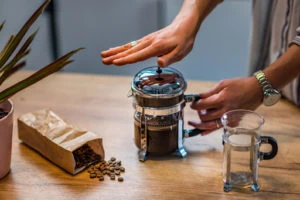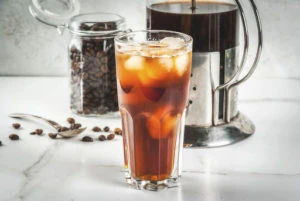You may have heard that when it comes to whetstones, Japanese water stones are among the best in the world. So, how do you find the best Japanese sharpening stone to test this out?
We’re glad that you asked!
Today, we’re going to tell you a little about these fantastic porous stones, so that you’ll know the proper Japanese names, the grits associated, and exactly what they’re used for. We’ll also review and share some of our favorites so that by the time we’re done you’ll be more than ready to try sharpening the Japanese way.
We’ll give you a hint – you definitely won’t be disappointed!
A brief history of Japanese sharpening stones
Sharpening stones have been around pretty much as long as tools have needed sharpening, but Japanese sharpening stones are distinctly different from the European and American varieties. You’ll often hear the term ‘water stones’ to describe them and while Euro or American varieties are oiled, water stones are, well, watered!
That’s because they are porous. Japanese water stones are formed based on the unique geology of Japan, which allows for a fine silicate array encased in a clay matrix. The resulting stones may be soaked in water for a few minutes and then provide a fine, water-lubricated surface that creates a slurry of shaved steel and stone on top when you use it.
That slurry is just one of the advantages, however, as these distinctive stones are also softer, so layers are removed more efficiently and you are essentially working with a new surface every time that you use them. Softer stones also have one remaining advantage over their harder cousins, in that they do not easily get compacted with materials or glaze over – a little cleanup with a Nagura stone (more on this later) can correct this problem in a jiffy on the rare occasions that you’ll see it.
As far as disadvantages when compared to sharpening stones around the world, the only caveat with Japanese stones comes from the softness – so you’ll use them up faster. That said, once you give them a try then we think you’re going to find that the cost is well worth the admission. These are fantastic stones for sharpening and many knife owners around the world swear by them!
Japanese sharpening stones also come in 3 grades – Ara-to, Naka-to, and Shiage, which are basically your coarse, medium, and fine grades for sharpening, and traditionally these stones were mined.
These days, those mined stones are certainly still available, but they are much rarer and considerably more costly. Thankfully, the introduction of synthetics makes it easy for you to own a quality set without breaking the bank and they work very well.
Typically made from silicon carbide or aluminum oxide, synthetic waterstones will help you to efficiently sharpen both your knives and your skills and who knows? Maybe someday you’ll upgrade to a mined stone and then you’ll have your own little piece of Japanese history!
The Best modern-day Japanese sharpening stones
With that little history lesson, we’re ready to take a look at the best modern-day Japanese sharpening stones and we’re including a variety so that there’s a little something for everyone. We’ve got various grits, in single or combo stone varieties, as well as some with bases, and 2 full beginner kits that we think you’re going to love.
Take a look and see what you think!
King Sharpening Stone – Combination K-80 Waterstone 250/1000 grit
View on AmazonYou’ll notice that we’re opening up with a number of offerings from King and that’s definitely on purpose.
Established in 1948 in Osaka, Japan, King has been an industry leader in producing quality Waterstone whetstones. This particular beauty is a combination stone, which provides you with a 250-grit coarse side, and a 1000-grit medium surface on the other side.
The 250 grit is considered a ‘fixing’ stone surface, that lets you repair chips and nicks to your blades, while the 1000 grit is considered a ‘medium’ grade so that you can do general sharpening. It’s not fine enough to polish with – you need a higher, finer grit for that – but it lets you do the basics and is great for beginners.
King Medium Grain Sharpening Stone K-1000 Waterstone
View on AmazonSome folks prefer to have a larger set of single-grade stones for their sharpening and that’s understandable – if there’s a grade that you use a lot, then you will get more mileage out of a single-grade stone than a combo variety. For those folks, this King Medium-grain is a nice fit.
You get a 1000 grit stone – through and through – that you can use for sharpening and also for minor repair of your blades. 1000 grit is also a grit that you’ll use a lot, so these are also good to have handy just to have a spare that you can wet and use right away when you want a ‘fresh’ stone.
King Knife Sharpener Whetstone 6000-Grit
View on AmazonKing’s 6000-grit sharpening stone is an excellent stone for polishing and finishing your knife blades. We should note that this stone won’t make your knife sharper – it’s simply part of the sharpening process, once you’ve repaired with a coarse stone and then sharpened it.
While 6000 sounds like a high number, it’s actually just considered ‘sufficiently robust’, as there are definitely higher grits, with some going as high as 30,000. While you might invest in one so high someday, we don’t recommend this for beginners for the simple fact that the higher the grit is, the higher the cost is going to be.
For now, a 6000 will polish up your knives just fine and this King whetstone definitely works well for this.
King 1000/6000 Whetstone
View on AmazonOur final King entry is a nice 1000 and 6000-grit combo stone, which will allow you to do minor repairs and sharpening, and then you can flip the stone, wet it, and give your blade a nice polish. This particular combination is quite popular and definitely, one to add to your collection.
Not only do you get the combo stone, but it also has a sturdy plastic base to help secure this and other King stones while you hone and sharpen your knives on it. It’s a great deal and you’ll get a lot of good use out of it, so what’s not to like?
Mitsumoto Sakari 1000/3000 grit whetstone
View on AmazonNext up we have a fantastic Mitsumoto Sakari sharpening stone that gives you a good 1000/3000 combination so that you can do minor repair and sharpening, as well as some basic polishing that should be perfectly fine for everyday knives such as steak knives, fruit knives, hunting blades, and other sharp implements that you’ll use often but won’t be displayed on the wall.
This set also comes with a nice bamboo base that has no-slip rubber underneath so that you won’t have to worry so much about it moving around when you are holding the blades at the angles you need to sharpen them. It’s a good-looking set and a great way to get used to the lower end of polishing grit for those times when you want your blades shiny, but not blindingly so.
Chosera 3000 grit Whetstone
View on AmazonIf you would like a nice finishing/polishing stone that is not a combination stone, then this Chosera 3000 grit is a great way to do so. Mounted on a plastic base, one of the perks of this stone is that it doesn’t need a whole lot of wetting to start using.
You can keep a spray bottle handy and give the surface a good spritzing and then you’re pretty much ready to go. We also like these for their durability – if you’ve got a few 3000 grit stones already, but haven’t got a Chosera one, we definitely recommend that you try it.
They do the job nicely and really, really last – you’ll thank us later!
Shapton Glass stone – 2000 grit
View on AmazonShapton provides an innovative Japanese sharpening stone in the form of their ‘glass stones’.
If you haven’t tried one, they are actually quite nice. The even distribution of particles provides a superior abrasive surface so that sharpening on one of these beauties is noticeably faster.
This particular grit is a perfect choice for sharpening blades after one or two uses, as it will quickly restore the cutting edge nicely. A lot of knife owners love to do this, so that their blades are always at their best, and this Shapton is just about perfect for this.
Masuta Natural Fine/Ultra honing stone
View on AmazonWe wanted to include a natural stone in our list and this Masuta is exactly that.
These natural blue sharpening stones are mined underwater, near South Tsushima Island. The grit range for this is between 10,000 and 12,000, so this natural whetstone is great for putting a fine polish and razor edge on your knife in the finishing stages of sharpening.
It is a little pricier, but natural stone is fairly rare, and it’s definitely worth having in your collection if you do a lot of sharpening and really want the perfect finish for your knives.
Goodjob Japanese Knife Sharpening kit 400/1000 grit
View on AmazonWhile the name doesn’t sound Japanese, Goodjob is actually a company that originated in Osaka, Japan, and boasts 500 years of knifemaking history. As they provide kits for beginners, we thought we’d be amiss if we didn’t include at least a couple, and this is the first of the pair we’ve chosen.
This particular kit has a 400 and a 1000 grit, so that you can both repair and sharpen blades, but it also comes with some nice extras, including:
- 1 non-slip rubber base
- 1 Angle guide
- 1 flattening stone
- Instruction manual for use
The angle guide will help you to learn the exact angle that you need for sharpening your blades, while the flattening stone is used to ‘even out’ your sharpening stones. You see when you do a lot of sharpening, your stones tend to wear the most in the middle, and the friction from your flattening stone helps to keep the stones uniformly flat.
It’s a great kit for beginners and even nice if you’re not a novice, so take a look at the link we’ve provided and see what you think!
Goodjob Premium Knife-sharpening kit 400/1000 3000/8000
View on AmazonOur final kit is our favorite from the list and you’re about to see why. The folks at Goodjob really put a lot of love into this, and here’s what you get:
- 2 combo grit stones – 1 with 400/1000 grit for repairs and sharpening, and a 3000/8000 for polishing your knives to a perfect finish
- 1 bamboo base
- 2 non-slip rubber mats
- 1 flattening stone
- 1 honing guide (it’s adjustable and helps to ensure you can hone the blade straight)
- 1 angle guide
- 2 leather stops (very cool – 1 for honing and one for sharpening)
- Polishing compound
- 1 part of cut-resistant gloves
It’s absolutely PERFECT for beginners and sharpening veterans alike. You’ve got all of your basics covered and you can buy it for less than the price of 2 loaded pizzas.
While this author will admit that the ‘coolness factor’ was greatly enhanced by the addition of strops, this really is an excellent deal for someone who wants a sharpening set that is ready to unpack, arrange in the workspace, and use right away!
Best tips for sharpening newbies
Everybody’s got to start somewhere, so if you are a novice-level sharpener, then don’t worry about it– we’ve got you covered.
In this section, we’ll tell you the names of the 3 types of Japanese sharpening stones, and give you a little advice that you can use as a foundation to build on as you practice with stones of your own. Let’s get started!
Knowing your grits – a quick tutorial for choosing your whetstones
When you are choosing a whetstone, you need to know what kind of grit is going to be best for your intentions. To help you with this, we’ll tell you a little about the Japanese names for the 3 grit ranges and what each range is intended for:
Arato (also called Aratoishi)– Arato stones are your ‘Rough’ or ‘Coarse’ grit stones, typically falling in a range of 200 – 700, and the rough surface of these stones is used to repair chips or otherwise damaged knives. Think Aratos as ‘fixing stones’ – they shave off the most metal to help restore a damaged edge.
Nakato (Also called Nakatoishi) – Nakato stones fall into the ‘Medium-rough Grit’ category, which is a range of 800 to 2000 grit, and you use these for sharpening, as well as general maintenance of your knives. Beginners will use Nakato stones the most, usually 1000 grit, as you can sharpen and do minor repairs with them.
Siageto (also called Sawato) – Siageto is the ‘Fine grit’ sharpening stone, which is all about aesthetics and perfecting the knife’s edge to razor sharpness. It covers a grit range of 3000 to 8000 (although you can buy expensive stones that go way over this. With your Siagetos, you are making the final touches on your knives, such as buffing out scratches, thinning the edge to perfection, or bringing your steel to a mirror shine.
Memorize the grit ranges and then the next time that you see Japanese whetstones, you’ll be able to tell by the grit whether they are Arato, Nakato, or Siageto. That way, even if there’s very little English on the box, you’ll know exactly what you’re getting and you can get exactly what you need!
Quick tips for use with your whetstones
- Don’t use oil on Japanese Waterstones – everything you need is in the name. Just check the instructions with your stone for good measure, and it will tell you if you can ‘spritz’ the stone or if you need to soak it for 5 minutes in water before use. While oil is good for European whetstones, Japanese water stones are porous, so keep the oil away and stick with your trusty H2O!
- Don’t worry about obtaining many super high grit stones or getting a mined whetstone right away – they’re costly and you’ll want to practice a bit before you start upgrading your collection too much. That said, for kitchen knives that will cut meat, you want a finishing grit of 4000 to 6000, while 8000 or higher is for effortlessly slicing through tough veggies!
- That funny gunk that appears on your whetstone when you are sharpening is called slurry and it’s useful stuff – but only while you are sharpening. It’s a mix of stone particles and shaved bits of steel, so while you sharpen it acts like a microgrit and also helps to polish the blades.
- You’ll want to clean that slurry, however, between sharpenings, so get a Nagura stone – here is an example from King. These stones may be rubbed on your sharpening stones after you’re done and they help to keep the porous surface from becoming overly clogged with slurry.
Tips when buying Japanese sharpening stones
If you go shopping at your local flea market or a gun and knives show, you’ll quite often find Japanese sharpening stones and accessories available, and so we’ve collected a few tips for you to help when you are evaluating and purchasing them on your own. Here are those tips:
- Don’t be afraid to purchase an angle guide. They’re cheap and one of the fastest ways to learn the exact angle that you need to be holding your blade to sharpen it.
- Softer stones are easier to use, but you’ll get better performance with harder ones. Be sure to get yourself a mix of both and you’ll learn the differences properly, as well as which type is best suited for your intentions at the time of sharpening.
- You’re not going to pick the perfect stone the first time, and maybe even not the second or third. Accept this and go with it – after you’ve gotten a little experience under your belt, then you’ll know the difference by the feel of the stones and it makes shopping for them a real treat.
- Your vendor should list the hardness and grit – with hardness, the lower the number, the softer the stone, and with grit the low numbers are coarser while the highest numbers are fine.
- If purchasing online, make sure that the seller is giving you a picture of the ACTUAL stone that you are buying, otherwise, you might be very unpleasantly surprised.
- With online vendors, go directly to the review section, and click the 1-star reviews first. Too often we tend to want something so bad that we skip this step, and then end up reading those bad reviews when it’s too late, so get in the habit of reading those first – it will save you a lot of cursing!
- If you are looking for natural stones, then save this link for the Japanese Natural Stones(JNATS) and Nagura Sellers list from naturalwhetstones.com – this will help to make sure that you can find a reputable dealer for these expensive stones.
Our Top product recommendations
Our absolute favorite from all of the sharpening stone listings we’ve shared today is definitely going to be the Goodjob Premium Knife-sharpening kit 400/1000 3000/8000. Not only does it provide you with all of the ranges that you need to get started, but they really go out of their way to give you a workspace-ready kit.
You’ll have an angle guide to help you practice and perfect how to hold your knife on the whetstone and a honing guide as well for keeping your knives straight and true. Add in that there’s a non-slip base for your stones, as well as a flattening stone, gloves, and strops (still very cool!), you’ve got an instant ‘sharpening corner’ or table that’s ready-made.
It also costs a pittance – hands down, this Goodjob set is the clear winner today!
FAQs
While we can’t cover every aspect of Japanese sharpening stones in the space that we have today, we’re certainly going to do our best! With that in mind, we’ve got a few frequently asked questions to address for you before we go and we hope that you’ll find the answers helpful.
Can you leave Japanese water stones in the water overnight?
Leaving your sharpening stones in water overnight is a definite no-no. Check the instructions on your specific stones for good measure, but in general, a 5-minute soak is all that you’ll need, and perhaps as long as 10 minutes for your coarsest stones. No more, no less, unless your instructions tell you specifically otherwise!
How often should I flatten Japanese Waterstones?
Flattening takes about 15 seconds once you’ve got the hang of it and we recommend that you flatten your stones every time before you use them.
Japanese water stones are very soft, and flattening them with each use will help to prevent more dramatic scenarios where the middle of your stone ends up too thin. By flattening them every time you use them, you’ll always have an ideal, flat surface whenever you need to sharpen your knives.
How do you take care of Japanese water stones?
If you have a heavy concentration of slurry, then you can use a Nagura stone for cleanup, and there’s a lovely walkthrough on the process at Knifewear which we’ve linked for you. You won’t need to do this often, however, as usually, you’ll just need to rinse your stones and then wipe them completely dry with a clean cloth.
After that, let them air out overnight and then you can safely store them away in the morning!
In Conclusion
One of the perks of dealing with sharpening stones from Japan is that they have a long history. As such, finding quality stones shouldn’t be difficult, as long as you stick with the tricks and tips that we’ve shared today.
Remember if you’re buying them online to get a pic of the actual stone and if a vendor can’t tell you the grit and the hardness, then it’s best to find another – otherwise, you won’t know what you’re getting! For beginners, a King combination water stone can give you a coarse grit for repairing and a medium grit for sharpening up your blade, and you should invest in some finer grits so that you can experience firsthand what they can do.
It’s going to take a little practice, but if you put in the time then we think you’ll soon find that Japanese sharpening stones are well worth your while. While they wear out a little more quickly than American and European whetstones, they more than make up for them with the results that you’ll be getting.
Give Japanese sharpening stones a try and you’ll see for yourself – Sometimes when there’s a lot of hype, there’s actually a good reason for it!















David learned to cook at an early age after his mother told him that he couldn't live on pizza forever, Dave uses his modest kitchen skills to recreate sorely-missed recipes from home and to occasionally make new favorite ones from places he is visiting.